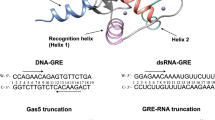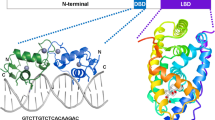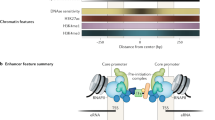Abstract
DNA sequences recognized by the glucocorticoid receptor1–4 are termed glucocorticoid-responsive elements1 because of their stimulatory effect on transcription. An oligonucleotide of 15 base pairs having partial or perfect symmetry is necessary for glucocorticoid induction5 and this same oligonucleotide is surprisingly also recognized by the progesterone receptor5. Here we define a palindromic sequence of 15 base pairs, modelled after a sequence element shared by the vitellogenin genes of frog and chicken6, which confers oestrogen inducibility on a heterologous promoter and can be converted into a glucocorticoid-responsive element by substitution of one or two bases at homologous positions in the palindrome. Considered with the observation that the DNA-binding domains of steroid receptors are closely related7, this finding demonstrates that the steroid-responsive elements constitute a family of related DNA sequences.
This is a preview of subscription content, access via your institution
Access options
Subscribe to this journal
Receive 51 print issues and online access
$199.00 per year
only $3.90 per issue
Buy this article
- Purchase on Springer Link
- Instant access to full article PDF
Prices may be subject to local taxes which are calculated during checkout
Similar content being viewed by others
References
Yamamoto, K. R. A. Rev. Genet. 19, 209–252 (1985).
Ringold, G. A. Rev. Pharmac. Tox. 25, 529–566 (1985).
Scheidereit, C., Westphal, H. M., Carlson, C., Bosshard, H. & Beato, M. DNA 5, 383–391 (1986).
Jantzen, H.-M. et al. Cell 49, 29–38 (1987).
Strähle, U., Klock, G. & Schütz, G. Proc. natn. Acad. Sci. U.S.A. (in the press).
Walker, P., Germond, J.-E., Brown-Luedi, M., Givel, F. & Wahli, W. Nucleic Acids Res. 12, 8611–8626 (1984).
Green, S. & Chambon, P. Nature 324, 615–617 (1986).
Klein-Hitpass, L., Schorpp, M., Wagner, U. & Ryffel, G. U. Cell 46, 1053–1061 (1986).
Seiler-Tuyns, A. et al. Nucleic Acids Res. 14, 8755–8770 (1986).
Horwitz, K. B., Zava, D. T., Thilagar, A. K., Jensen, E. M. & McGuire, W. L. Cancer Res. 38, 2434–2437 (1978).
Gorman, C. M., Moffat, L. F. & Howard, B. H. Molec. cell. Biol. 2, 1044–1051 (1982).
Zinn, K., DiMaio, D. & Maniatis, T. Cell 34, 865–879 (1983).
Melton, D. A. et al. Nucleic Acids Res. 12, 7035–7056 (1984).
Miksicek, R. et al. Cell 46, 283–290 (1986).
King, R. J. B. & Mainwaring, W. J. P. in Steroid-Cell Interactions (Butterworth, London, 1974).
Rochefort, H., Garcia, M., Vignon, F. & Westley, B. in Steroid induced uterine proteins (ed. Beato, M.). 171–182 (Elsevier, Amsterdam, 1980).
Dabre, P., Page, M. & King, R. J. B. Molec. cell. Biol. 6, 2847–2854 (1986).
Cato, A. C. B., Henderson, D. & Ponta, H. EMBO J. 6, 363–368 (1987).
Luckow, B. & Schütz, G. Nucleic Acids Res. 15, 5490 (1987).
Author information
Authors and Affiliations
Rights and permissions
About this article
Cite this article
Klock, G., Strähle, U. & Schütz, G. Oestrogen and glucocorticoid responsive elements are closely related but distinct. Nature 329, 734–736 (1987). https://doi.org/10.1038/329734a0
Received:
Accepted:
Issue Date:
DOI: https://doi.org/10.1038/329734a0
This article is cited by
-
A review of the serotonin transporter and prenatal cortisol in the development of autism spectrum disorders
Molecular Autism (2013)
-
Transcriptional activation by the oestrogen receptor α is modulated through inhibition of cyclin-dependent kinases
Oncogene (2002)
-
Effect of 17β‐oestradiol on cytokine‐induced nitric oxide production in rat isolated aorta
British Journal of Pharmacology (1998)
-
The vitamin D3 receptor in the context of the nuclear receptor superfamily
Endocrine (1996)
Comments
By submitting a comment you agree to abide by our Terms and Community Guidelines. If you find something abusive or that does not comply with our terms or guidelines please flag it as inappropriate.



